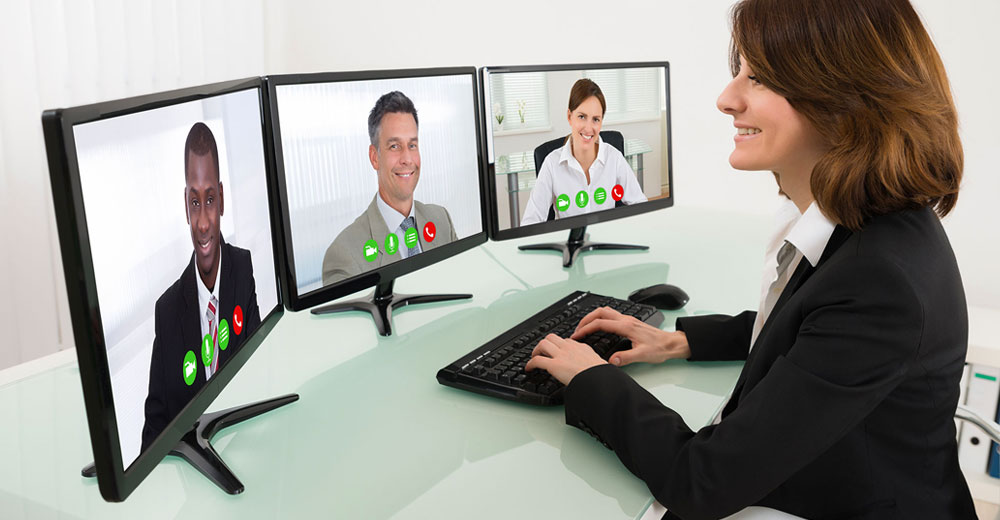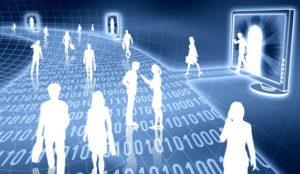There are several questions and issues surrounding COVID-19. Did it mutate from a Pangolin virus, or was it manufactured and accidentally released? I thought the second possibility was a hoax, but I understand that the Department of Defense isn’t so sure. (In any case, the controls around the Chinese labs were tightened.)
While many think this virus will mitigate in the summer, the consensus is that no one is sure if that is the case. We apparently have no immunity to it, and a vaccine likely is around 18 months away.
Further, this is a mutating virus with multiple strains, making it likely that whatever antiviral approach we develop won’t work on the strain that is spreading when it becomes available. Finally, climate change increases the likelihood that we’ll see an increase in viruses like COVID-19.
It takes a while to change human behavior, but if we go a full 18 months or more with people working from home and avoiding places like malls, big box stores, and other areas where people congregate — like offices and events — it will force a fundamental, permanent change in the way we work and interact.
I expect we’ll see a decline in large malls in favor of smaller, more intimate shopping venues, and online shopping will accelerate sharply. We are going to be seeing changes in airlines, ships, and most forms of public transportation as well. I’ll bet that many firms entering this virus-driven cycle won’t exit it.
I’ll share my views on how COVID-19 will change the way we work and interact and how it will impact office architecture and events. I’ll close with my product of the week: a hot new gaming smartphone from Xiaomi that uses Qualcomm’s most powerful Snapdragon chipset, the Black Shark 3 Pro — and it is a monster.
Changing the Way, We Live and Work
Obvious changes already are happening: not kissing people as a greeting (which came from an old practice of sharing already chewed food, yuck); avoiding handshakes; sneezing and coughing into increasingly infected sleeves (I’d suggest not grabbing anyone’s elbow either); and avoiding touching our faces. These practices are already being locked in, particularly for kids who haven’t yet formed these bad habits.
Think of the broader issues, however. Are cubicles — which initially were designed as temporary emergency workspaces, not full-time employee cells — going to become obsolete? They should, because they won’t contain a pathogen if a sick person brings one in. Moving people into offices won’t help because COVID-19 can spread through offices as well. If office buildings are going to continue to be a thing, they’ll need to modify with HVAC systems developed for the healthcare industry, which isolate and kill pathogens.
The offices of today, if they are to remain, will need massive modifications to be made safe for employees: automatic doors so employees don’t have to touch handles; more privacy (isolation) in bathrooms and other areas where people congregate. Lunch deliveries may take the place of cafeterias.
The cheapest and easiest path would be to go to an aggressive work-at-home strategy so companies don’t become more liable for allowing pathogens to spread across their employee and customer base. Offices that remain in place will be far smaller, and their designs may emulate hospitals.
Schools are equally problematic in that they tend to be old and very hard to sterilize. They also tend to group lots of students in what could become virus incubation centers. Interacting with professors and studying from home could well become the norm in a few years.
Kids currently homeschooled may not always get the best education, but they are far less likely to get sick, suggesting a move to improve support for homeschooling in preference to building schools will become a near-term future trend.
It is nice to see that Cisco massively expanded its free Webex offer to include both countries that have COVID-19 problems and those that haven’t yet shown them. Webex is one of the leading remote conferencing solutions for enterprises.
I expect that tools like Microsoft’s Yammer will increasingly be used to facilitate collaboration across large pools of remote employees.
The Death of Events
I’m about to call events effectively dead, at least for the near-term future. With all of the cancellations, any firm that has a big event where attendees get sick likely could be charged with negligence, and if a person should die, criminal charges conceivably could be filed. (South Korea is going after a religious leader for murder.)
Given that it’s unlikely COVID-19 will go away very soon and that similar viruses likely will follow, it increasingly seems that big personal events will go into sharp decline. Should one company effectively be sued for damages stemming from a large-scale event or be found criminally negligent, the entire industry could collapse.
Virtual conferences historically have not been very successful, largely because the people who put them on do not have entertainment industry backgrounds. With a virtual event, you can’t get away with the death-by-PowerPoint approach taken at many current conferences because people will minimize the window and go back to doing what they prioritize more highly.
Even with traditional events, it is amazing how many people in the audience don’t pay any attention to what is on stage. I’ve often advised clients to put a camera on the audience and design flexibility into the program so that if it loses the audience’s attention, you can mix it up and get that attention back.
For a virtual event, you have to be able to monitor and engage the attendees. Otherwise, you are unlikely to hold them for more than 15 minutes. Fifteen minutes isn’t random. Back in the 1980s, a Dataquest study found that if a presentation didn’t engage someone within 15 minutes, that audience member would be lost and unlikely to return.
The need to keep remote audiences focused suggests that in order to engage people and increase sales, firms will need to monitor their audiences, take direction from media companies that know how to make presentations interesting to watch, and create virtual experiences that are both entertaining and dynamic.
One of the few executives I’ve known who seemed to understand this was Steve Jobs. It is a skill also commonly used by televangelists, comedians, and successful politicians.
Presenters will need to be chosen because they are entertaining to listen to, not because they have a title. I expect many firms will turn to screen professionals to do the pitch and have the executives and engineers answer the questions over time.
Other Changes
I expect online shopping and concepts like Amazon Go will accelerate so that people don’t have to go to large stores to shop. Restaurants likely will have to change as well, and there should be a huge push for robotic food preparation. People are going to get nervous about the thought of someone who might be sick preparing their food. (Granted, this hasn’t seemed to faze people who mistreat wait staff, despite the common belief that mistreated wait staff spit in food, which I knew to happen when I was in food). As a side note, if you do go out to eat, you might want to be extra nice to the wait staff. Just saying
If you look at aircraft seating, airlines have been pushing ever tighter seating and making travel hell. A side effect is that if a person sneezes, the pathogens now spread to a lot more people.
If airlines want to remain in business, I expect they are going to have to figure out a safer way to move people. Otherwise, concerns that one person on a plane can get the entire plane quarantined or sick could massively reduce the number of people who will be able to fly, let alone want to.
Cruise ships may already be dead after people saw them house sick and well people together and not allow anyone to leave, increasing the risk for both the sick and healthy. My wife and I pretty much swore off cruise ships after seeing that. They need to update and improve their policies surrounding contagious illness and find ways to get sick people off a ship more quickly.
Wrapping Up
The COVID-19 virus, if it continues at near-pandemic or pandemic levels for 12 to 18 months, will change how we do things. We’ll likely be more isolated. Communal practices like parties and dating will be reconsidered depending on how concerned people get with the virus’ spread.
Many, if not most of us, will work from home if possible. We will travel far less, and travel likely will get more expensive but less dense. Events will have to become both more virtual and more interesting — otherwise, sales are going to take a bigger hit. For those of us who do go into offices, we’ll likely find buildings redesigned with protections that emulate those found in healthcare facilities. So some good, some bad.
I expect that 12 months from now, our working and personal lives will be very different from today unless summer does take out the virus, which right now looks doubtful. Hope you like change.
The idea of a water-cooled gaming smartphone has me lusting for this device. The Black Shark 3 Pro from Xiaomi (one of the largest Asian phone makers) is a beast of a phone, costing a pretty reasonable US$675 (estimate).

It has a near tablet-size screen at 7.1 inches. It isn’t a cheap screen either, given it is 1440p and AMOLED with a 90-Hz refresh rate consistent with the phone’s gaming focus. Cameras aren’t bad for a premium phone either, with triple cameras providing 66- 13- or 5-megapixel back cameras and a 20-megapixel selfie camera.
It ships with a 5,000mAh battery, and it will take a 65W charger for extremely fast charging. The phone comes in two colors: Knight Grey and Blasting Black. It has capacitive pop-up shoulder pads and 270-Hz touch sampling for amazing speed and performance. This phone is one of the first full-performance 5G phones with WiFi 6 as well.
Oh, and it has 256 GB of storage, or about the same as my go-to laptop configuration. This phone also uses the new Qualcomm 865 solution, and you can get it with 8GB or 12GB of RAM.
The Black Shark 3 is the first phone I know of to use liquid cooling, like gaming machines, aggressively. It even has a special antenna solution designed to increase connection reliability and reduce latency, which is critical for gamers.
This phone is a gaming phone, and everything about it screams performance. It even lights up in a cool gaming fashion. It will be available for pre-order in China this week and move to the rest of the world shortly after.
The idea of a gaming PC-like device that you can carry in your pocket has me lusting for the Black Shark 3. It would be perfect for Nvidia’s cloud gaming service because streaming a PC game on this puppy would be a ton of fun.
Because I saw this phone and now lust for it, the Xiaomi Black Shark 3 Pro is my product of the week. I think it is AWESOME!


























































